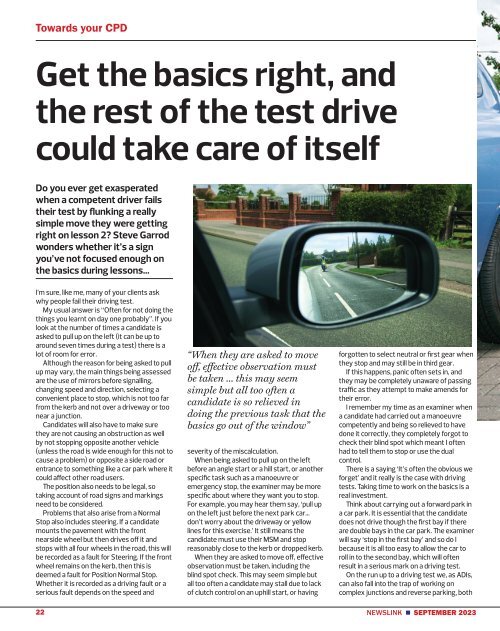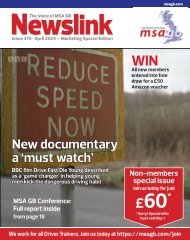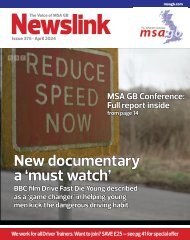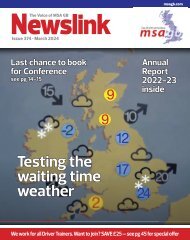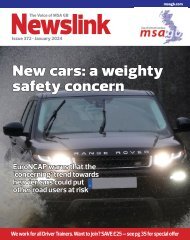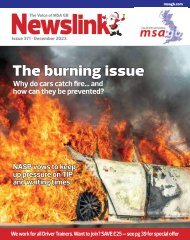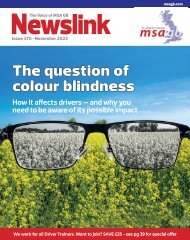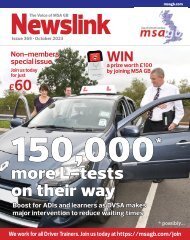Newslink September 2023
Motor Schools Association - driver training and testing - road safety
Motor Schools Association - driver training and testing - road safety
Create successful ePaper yourself
Turn your PDF publications into a flip-book with our unique Google optimized e-Paper software.
Towards your CPD<br />
Get the basics right, and<br />
the rest of the test drive<br />
could take care of itself<br />
Do you ever get exasperated<br />
when a competent driver fails<br />
their test by flunking a really<br />
simple move they were getting<br />
right on lesson 2? Steve Garrod<br />
wonders whether it’s a sign<br />
you’ve not focused enough on<br />
the basics during lessons...<br />
I’m sure, like me, many of your clients ask<br />
why people fail their driving test.<br />
My usual answer is “Often for not doing the<br />
things you learnt on day one probably”. If you<br />
look at the number of times a candidate is<br />
asked to pull up on the left (it can be up to<br />
around seven times during a test) there is a<br />
lot of room for error.<br />
Although the reason for being asked to pull<br />
up may vary, the main things being assessed<br />
are the use of mirrors before signalling,<br />
changing speed and direction, selecting a<br />
convenient place to stop, which is not too far<br />
from the kerb and not over a driveway or too<br />
near a junction.<br />
Candidates will also have to make sure<br />
they are not causing an obstruction as well<br />
by not stopping opposite another vehicle<br />
(unless the road is wide enough for this not to<br />
cause a problem) or opposite a side road or<br />
entrance to something like a car park where it<br />
could affect other road users.<br />
The position also needs to be legal, so<br />
taking account of road signs and markings<br />
need to be considered.<br />
Problems that also arise from a Normal<br />
Stop also includes steering. If a candidate<br />
mounts the pavement with the front<br />
nearside wheel but then drives off it and<br />
stops with all four wheels in the road, this will<br />
be recorded as a fault for Steering. If the front<br />
wheel remains on the kerb, then this is<br />
deemed a fault for Position Normal Stop.<br />
Whether it is recorded as a driving fault or a<br />
serious fault depends on the speed and<br />
“When they are asked to move<br />
off, effective observation must<br />
be taken ... this may seem<br />
simple but all too often a<br />
candidate is so relieved in<br />
doing the previous task that the<br />
basics go out of the window”<br />
severity of the miscalculation.<br />
When being asked to pull up on the left<br />
before an angle start or a hill start, or another<br />
specific task such as a manoeuvre or<br />
emergency stop, the examiner may be more<br />
specific about where they want you to stop.<br />
For example, you may hear them say, ‘pull up<br />
on the left just before the next park car…<br />
don’t worry about the driveway or yellow<br />
lines for this exercise.’ It still means the<br />
candidate must use their MSM and stop<br />
reasonably close to the kerb or dropped kerb.<br />
When they are asked to move off, effective<br />
observation must be taken, including the<br />
blind spot check. This may seem simple but<br />
all too often a candidate may stall due to lack<br />
of clutch control on an uphill start, or having<br />
forgotten to select neutral or first gear when<br />
they stop and may still be in third gear.<br />
If this happens, panic often sets in, and<br />
they may be completely unaware of passing<br />
traffic as they attempt to make amends for<br />
their error.<br />
I remember my time as an examiner when<br />
a candidate had carried out a manoeuvre<br />
competently and being so relieved to have<br />
done it correctly, they completely forgot to<br />
check their blind spot which meant I often<br />
had to tell them to stop or use the dual<br />
control.<br />
There is a saying ‘It’s often the obvious we<br />
forget’ and it really is the case with driving<br />
tests. Taking time to work on the basics is a<br />
real investment.<br />
Think about carrying out a forward park in<br />
a car park. It is essential that the candidate<br />
does not drive though the first bay if there<br />
are double bays in the car park. The examiner<br />
will say ‘stop in the first bay’ and so do I<br />
because it is all too easy to allow the car to<br />
roll in to the second bay, which will often<br />
result in a serious mark on a driving test.<br />
On the run up to a driving test we, as ADIs,<br />
can also fall into the trap of working on<br />
complex junctions and reverse parking, both<br />
22 NEWSLINK n SEPTEMBER <strong>2023</strong>


